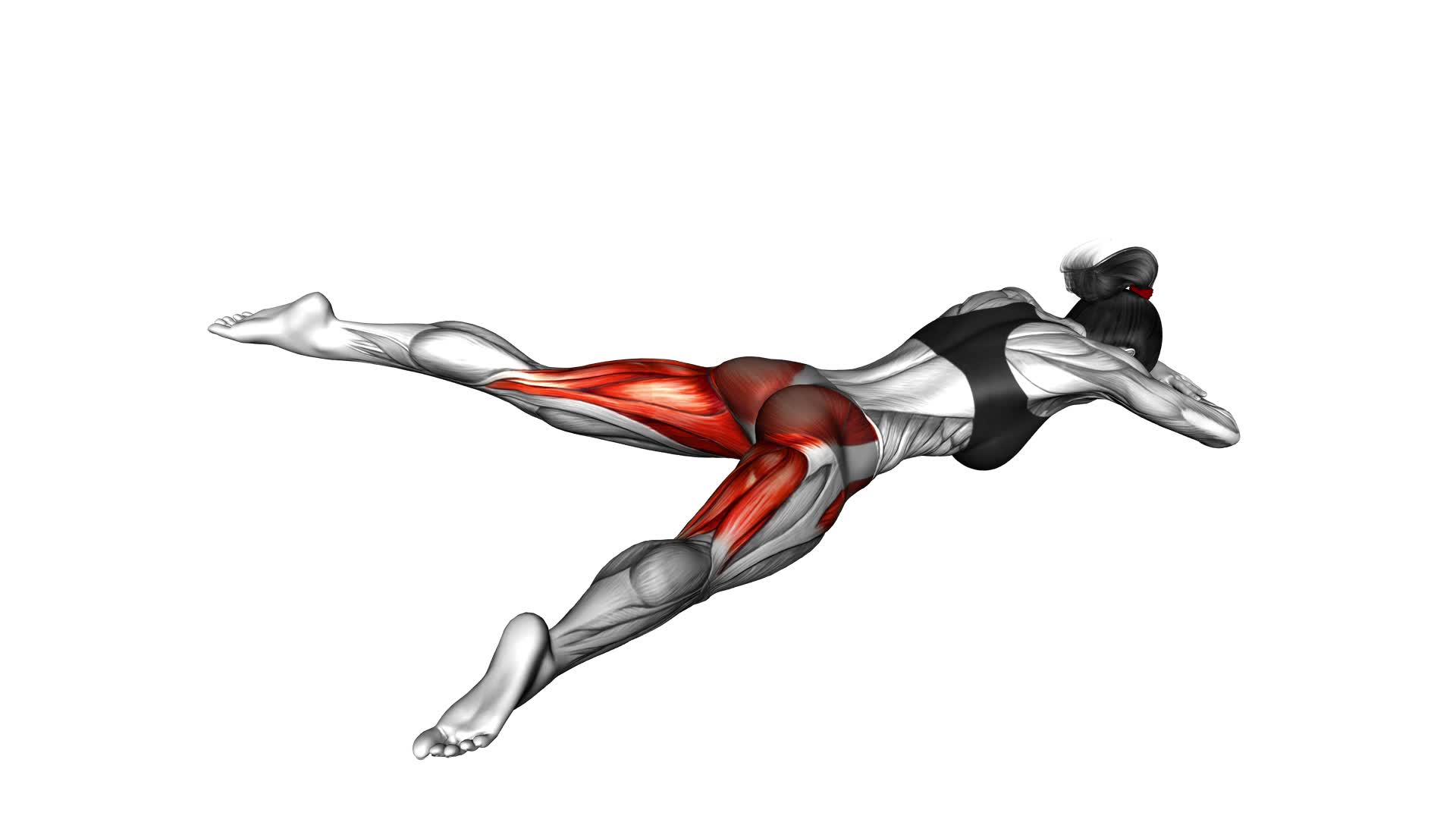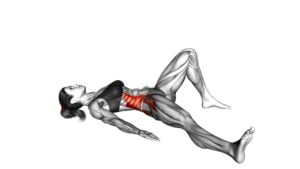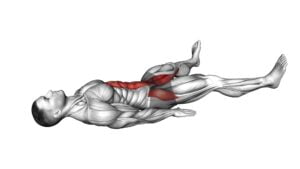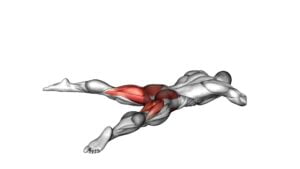Lying Leg Abduction (female) – Video Exercise Guide & Tips

Are you looking for a new exercise to target your lower body? Lying leg abduction is a fantastic choice! This video exercise guide will show you the proper form and technique to maximize your results.
Watch This Exercise Video
Avoid common mistakes and challenge yourself with variations. Whether you're a beginner or a seasoned fitness enthusiast, incorporating lying leg abduction into your workout routine will help you tone and strengthen your muscles.
Get ready to feel the burn!
Key Takeaways
- Lying leg abduction exercises strengthen hip muscles and improve lower body stability.
- These exercises target and engage the glute muscles, enhancing hip stability and preventing imbalances and weaknesses.
- Proper form and technique, such as engaging core muscles and maintaining tension in the muscles, are crucial for effective results.
- Variations of lying leg abduction exercises, such as using resistance bands or performing on an unstable surface, can increase intensity and challenge different areas of the glutes.
Benefits of Lying Leg Abduction
The benefits of performing lying leg abduction are numerous and can greatly contribute to strengthening your hip muscles and improving your overall lower body stability. This exercise specifically targets and engages your glute muscles, which are responsible for hip extension and rotation. By regularly incorporating lying leg abduction into your workout routine, you can effectively strengthen and tone these muscles, resulting in improved hip stability.
During the exercise, you lie on your side with your legs extended and lift your top leg upwards while keeping it straight. This movement helps activate and engage the gluteus medius and minimus, which are important for stabilizing the hips during everyday activities such as walking, running, and climbing stairs. Strengthening these muscles can help prevent injuries, such as hip pain or instability, and improve your overall balance and coordination.
Additionally, lying leg abduction also targets the hip adductors, which are the muscles responsible for bringing your legs together. By strengthening these muscles, you can improve your ability to control movements and maintain proper alignment in your lower body.
Incorporating lying leg abduction into your fitness routine can have significant benefits for your hip muscles and overall lower body stability. By targeting and strengthening your glute muscles and hip adductors, you can enhance your physical performance and reduce the risk of injuries.
Proper Form and Technique
To perform lying leg abduction with proper form and technique, start by lying on your side with your legs extended and lift your top leg upwards while keeping it straight. Here's a step-by-step guide to help you achieve correct form:
- Lie on your side on a mat, with your legs extended straight out in front of you.
- Keep your lower leg bent and rest it on the ground for support.
- Engage your core muscles by pulling your belly button towards your spine.
- Slowly lift your top leg upwards, making sure to keep it straight throughout the movement.
- Lift your leg as high as you comfortably can, without compromising your form.
- Pause for a moment at the top of the movement, focusing on squeezing your glute muscles.
- Slowly lower your leg back down to the starting position.
- Repeat the exercise for the desired number of repetitions, then switch to the other side.
Some common misconceptions about lying leg abduction include thinking that lifting the leg too high will yield better results or that using heavy weights is necessary. In reality, it's important to focus on maintaining proper form and controlled movements rather than going for excessive range of motion or heavy weights.
If you're looking for alternative exercises to target the same muscle group, you can try standing leg abductions, seated leg abductions, or resistance band leg abductions. Remember to always consult with a qualified fitness professional to ensure proper form and technique.
Common Mistakes to Avoid
Avoid these common mistakes when performing lying leg abduction.
As a beginner, it's important to be aware of these errors to ensure you get the most out of your workout and prevent any potential injuries.
One common mistake is using momentum to lift your legs instead of relying on the targeted muscles. Remember to engage your core and focus on using your hip abductors to lift your legs. This will ensure that you're effectively targeting the right muscles and getting the maximum benefit from the exercise.
Another mistake to avoid is lifting your legs too high. While it may be tempting to push yourself to lift your legs as high as possible, doing so can put unnecessary strain on your lower back. Instead, focus on lifting your legs to a comfortable height where you can feel the tension in your hip abductors.
Additionally, avoid letting your legs fall back down quickly after lifting them. This can cause a loss of tension in the muscles and decrease the effectiveness of the exercise. Instead, lower your legs slowly and under control to maintain constant tension throughout the movement.
Variations to Challenge Yourself
To challenge yourself during lying leg abduction exercises, there are several variations you can try.
One option is to advance to more advanced abduction exercises, such as using resistance bands or ankle weights.
Another way to increase the challenge is by incorporating stability training, such as performing the exercise on an unstable surface like a Bosu ball.
Advanced Abduction Exercises
Try incorporating advanced abduction exercises into your workout routine to challenge yourself and take your fitness to the next level.
Here are some advanced variations and techniques to keep pushing yourself:
- Resistance Band Abductions: Attach a resistance band around your ankles and perform the leg abduction movement. The resistance from the band will add an extra challenge to your muscles.
- Weighted Abductions: Hold a dumbbell or a kettlebell against your outer thigh while performing the leg abduction. The added weight will intensify the exercise and engage your muscles even more.
*Note*: Make sure to choose a weight that challenges you but still allows you to maintain proper form.
Increasing Resistance for Challenge
To continue challenging yourself and take your fitness to the next level, incorporate variations that increase resistance for a more intense workout.
Increasing the intensity of your lying leg abduction exercises can help you build strength and target your glutes and outer thighs even more effectively.
One way to increase resistance is to use ankle weights. By strapping on ankle weights, you add extra resistance to your leg lifts, making the exercise more challenging.
Another option is to use resistance bands. Attach a resistance band around your legs just above your knees and perform the leg abduction exercise. This added resistance will engage your muscles even more, providing a greater challenge.
Lastly, you can try modified exercises such as single-leg abduction or side plank abduction to further increase the intensity and work your muscles in different ways.
Incorporating these variations will push your limits and help you achieve your fitness goals.
Incorporating Stability Training
To challenge yourself and enhance your stability during lying leg abduction exercises, incorporate variations that involve balance and coordination. Here are two ways you can incorporate stability training into your routine:
- Single-leg stability: Perform the lying leg abduction exercise while balancing on one leg. This will challenge your core stability and improve your overall balance.
- BOSU ball modification: Place a BOSU ball (a half-sphere stability tool) under your hips while performing the leg abduction exercise. This unstable surface will require your core muscles to work harder to maintain balance and stability.
Tips for Beginners
If you're new to lying leg abduction exercises, it's important to focus on proper form and start with lighter weights. This will help you avoid injury and build a strong foundation for more advanced variations. As a beginner, it's recommended to perform the exercise without any modifications initially, as it will help you understand the movement pattern and engage the correct muscles effectively. Once you have mastered the basic form, you can gradually increase the intensity by adding resistance bands or ankle weights.
When it comes to the best time to perform lying leg abduction exercises, it's generally recommended to include them in your lower body or glute-focused workout routine. This exercise targets the gluteus medius, which is an important muscle for hip stability and overall lower body strength. By incorporating lying leg abductions into your routine, you can improve your hip strength, stability, and prevent any imbalances or weaknesses.
Remember to always listen to your body and start with a weight that's challenging but manageable. Consistency and proper form are key to progress in any exercise. So take your time, focus on the correct technique, and gradually increase the difficulty level as you get stronger.
Incorporating Lying Leg Abduction Into Your Workout Routine
Once you have mastered the proper form and technique for lying leg abduction exercises, it's time to incorporate this effective glute-strengthening movement into your regular workout routine. Here are some tips to help you do just that:
- Start by adding lying leg abductions to your lower body workout routine, performing them 2-3 times per week.
- Begin with 2-3 sets of 10-12 repetitions, focusing on maintaining proper form throughout each set.
- Gradually increase the number of sets and repetitions as your strength and endurance improve.
You can also modify lying leg abductions to target different areas of your glutes. To emphasize the outer glutes, place a resistance band around your thighs, just above your knees, and perform the exercise. To target the gluteus medius, elevate your upper body by propping yourself up on your forearms or placing a small pillow under your chest.
If you're looking for alternative abductor exercises, consider incorporating side-lying leg lifts or standing lateral leg raises into your routine. These exercises can provide a similar level of glute activation and help to strengthen the abductor muscles.
Remember to always consult with a fitness professional or trainer to ensure proper form and technique. Now that you know how to incorporate lying leg abductions into your workout routine, get ready to feel the burn in your glutes!
Frequently Asked Questions
How Many Repetitions and Sets Should I Do for Lying Leg Abduction Exercises?
For lying leg abduction exercises, the repetition range and number of sets depend on your fitness level and goals. Generally, aim for 8-12 repetitions per set. Take 30-60 seconds of rest between sets to allow your muscles to recover.
Adjust the repetition range and sets based on your comfort and ability to maintain proper form. Remember to consult with a fitness professional for personalized guidance and to avoid overexertion.
Can Lying Leg Abduction Exercises Help in Reducing Hip and Thigh Fat?
Lying leg abduction exercises can be effective for overall lower body toning. They target the hip and thigh muscles, helping to strengthen and tone them.
However, it's important to note that spot reduction of fat isn't possible. To reduce hip and thigh fat, it's necessary to incorporate lying leg abduction exercises into a comprehensive thigh and hip fat loss program.
This program should include a combination of cardio exercises, strength training, and a healthy diet.
Is Lying Leg Abduction Suitable for People With Knee or Lower Back Pain?
Lying leg abduction may not be suitable for people with knee or lower back pain. It's important to listen to your body and avoid any exercises that cause discomfort.
If you experience pain during this exercise, consider modifying it or trying alternative exercises that target the same muscles without putting strain on your knees or lower back. Consulting with a fitness professional or physical therapist can help you find the right modifications or alternative exercises for your specific needs.
Can Lying Leg Abduction Exercises Be Done With Resistance Bands?
Yes, you can definitely do lying leg abduction exercises with resistance bands. Resistance band variations can add an extra challenge to your workout and help strengthen your hip muscles.
They provide resistance throughout the entire range of motion, making the exercise more effective.
However, if you don't have access to resistance bands, there are alternative exercises you can try, such as side-lying leg lifts or clamshells, which also target the same muscle group.
Are There Any Specific Warm-Up Exercises Recommended Before Performing Lying Leg Abduction Exercises?
Before performing lying leg abduction exercises, it's important to warm up your body properly. Engaging in dynamic stretches like leg swings or hip circles can help activate the muscles you'll be targeting.
Additionally, performing some light cardio exercises like jogging or jumping jacks can increase blood flow and prepare your body for the workout.
Conclusion
Incorporating lying leg abduction into your workout routine can have numerous benefits for women. This exercise targets the outer thighs and hip muscles, helping to strengthen and tone these areas.
By maintaining proper form and technique, you can maximize the effectiveness of the exercise and reduce the risk of injury. Avoid common mistakes such as lifting the leg too high or using momentum to perform the movement.
Challenge yourself with different variations to keep progressing and continually challenge your muscles. Beginners can start with lighter resistance and gradually increase as they become more comfortable.

Author
Years ago, the spark of my life’s passion ignited in my mind the moment I stepped into the local gym for the first time. The inaugural bead of perspiration, the initial endeavor, the very first surge of endorphins, and a sense of pride that washed over me post-workout marked the beginning of my deep-seated interest in strength sports, fitness, and sports nutrition. This very curiosity blossomed rapidly into a profound fascination, propelling me to earn a Master’s degree in Physical Education from the Academy of Physical Education in Krakow, followed by a Sports Manager diploma from the Jagiellonian University. My journey of growth led me to gain more specialized qualifications, such as being a certified personal trainer with a focus on sports dietetics, a lifeguard, and an instructor for wellness and corrective gymnastics. Theoretical knowledge paired seamlessly with practical experience, reinforcing my belief that the transformation of individuals under my guidance was also a reflection of my personal growth. This belief holds true even today. Each day, I strive to push the boundaries and explore new realms. These realms gently elevate me to greater heights. The unique combination of passion for my field and the continuous quest for growth fuels my drive to break new ground.



